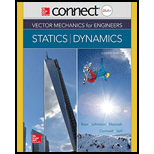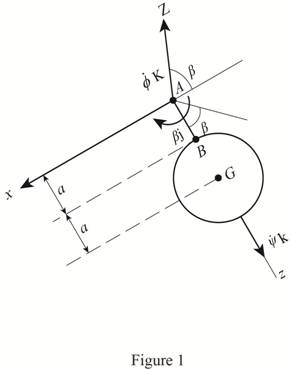
Concept explainers
(a)
The rate of precession
(a)
Answer to Problem 18.142P
The rate of precession
Explanation of Solution
Given information:
The position of the sphere
The largest value of
Calculation:
Conservation of angular momentum about the Z and z axes:
The only external forces are acting in homogenous sphere is weight of the sphere and reaction at A. Hence, the angular momentum is conserved about the Z and z axes.
Choose the principal axes
Write the expression for the angular velocity
The principal moment of inertia are
Draw the Free body diagram of homogeneous sphere and the forces acting on it as in Figure (1).

Write the expression for the angular momentum about point A.
Substitute
Consider
The scalar value of
Determine the conservation of angular momentum about fixed Z axis
Substitute
Substitute
Substitute
Determine the constant value using the angular momentum along z–axis.
Substitute
Substitute
Substitute 0 for constant in Equation (3).
Substitute 0 for
Conservation of energy:
Determine the value of kinetic energy T.
Substitute
Select the datum at
Determine the value of conservation of energy using the relation.
Here, E is the constant and V is the potential energy.
Substitute
Substitute
Substitute
Consider
Substitute
Substitute
Therefore, the rate of precession
(b)
The rates of precession
(b)
Answer to Problem 18.142P
The rate of precession
The rate of spin
Explanation of Solution
Given information:
The position of the sphere
The largest value of
Calculation:
Determine the rate of precession
Substitute
Therefore, the rate of precession
Determine the rate of spin
Substitute
The rate of spin
Want to see more full solutions like this?
Chapter 18 Solutions
Connect 2 Semester Access Card for Vector Mechanics for Engineers: Statics and Dynamics
- A uniform thin disk with a 6-in. diameter is attached to the end of a rod AB of negligible mass that is supported by a ball-and-socket joint at point A. Knowing that the disk is observed to precess about the vertical axis AC at the constant rate of 36 rpm in the sense indicated and that its axis of symmetry AB forms an angle β= 60° with AC, determine the rate at which the disk spins about rod AB.arrow_forwardA uniform thin disk with a 6-in. diameter is attached to the end of a rod AB of negligible mass that is supported by a ball-and-socket joint at point A. Knowing that the disk is spinning about its axis of symmetry AB at the rate of 2100 rpm in the sense indicated and that AB forms an angle β = 45° with the vertical axis AC, determine the two possible rates of steady precession of the disk about the axis AC.arrow_forwardIn order to determine the mass moment of inertia of a flywheel of radius 600 mm, a 12-kg block is attached to a wire that is wrapped around the flywheel. The block is released and is observed to fall 3 m in 4.6 s. To eliminate bearing friction from the computation, a second block of mass 24 kg is used and is observed to fall 3 m in 3.1 s. Assuming that the moment of the couple due to friction remains constant, determine the mass moment of inertia of the flywheel.arrow_forward
- A homogeneous cone with a height of h = 12 in. and a base with a diameter of d = 6 in. is attached as shown to a cord AB. Knowing that the angles that cord AB and the axis BC β=45 = 45° and 0= 30° and that the cone precesses at the constant rate O=8rd/s in the sense indicated, determine (a ) the rate of spin of the cone about its axis BC, (b ) the length of cord AB,arrow_forwardA 1300-kg sports car has a center of gravity G located a distance h above a line connecting the front and rear axles. The car is suspended from cables that are attached to the front and rear axles as shown. Knowing that the periods of oscillation are 4.04 s when L = 4 m and 3.54 s when L = 3 m, determine h and the centroidal radius of gyration.arrow_forwardA long ladder of length l, mass m, and centroidal mass moment of inertia I is placed against a house at an angle 0=0O. Knowing that the ladder is released from rest, determine the angular velocity of the ladder when 0=02. Assume the ladder can slide freely on the horizontal ground and on the vertical wall.arrow_forward
- A four-bladed airplane propeller has a mass of 160 kg and a radius of gyration of 800 mm. Knowing that the propeller rotates at 1600 rpm as the airplane is traveling in a circular path of 600-m radius at 540 km/h, determine the magnitude of the couple exerted by the propeller on its shaft due to the rotation of the airplane.arrow_forwardA coin is tossed into the air. It is observed to spin at the rate of 600 rpm about an axis GC perpendicular to the coin and to precess about the vertical direction GD Knowing that GC forms an angle of 15° with GD, determine (a) the angle that the angular velocity w of the coin forms with G (b) the rate of precession of the coin about GD.arrow_forwardA uniform disc having a mass of 10 kg and a radius of gyration of 175 mm is mounted on one end of a horizontal arm of 500-mm length. The other end of the arm can rotate freely in a universal bearing. The disc is given a clockwise spin of 350 rpm as seen from the disc end of the arm. Determine the angular velocity of precession.arrow_forward
- The shutter shown was formed by removing one quarter of a disk of 0.75-in. radius and is used to interrupt a beam of light emanating from a lens at C. Knowing that the shutter weighs 0.125 lb and rotates at the constant rate of 24 cycles per second, determine the magnitude of the force exerted by the shutter on the shaft at Aarrow_forwardA flywheel of mass 10 kg and radius of gyration 200 mm is spinning about its axis, which is horizontaland is suspended at a point distant 150 mm from the plane of rotation of the flywheel. Determine theangular velocity of precession of the flywheel. The spin speed of flywheel is 900 r.p.m.arrow_forwardThe space capsule has no angular velocity when the jet at A is activated for 1 s in a direction parallel to the axis. Knowing that the capsule has a mass of 1000 kg, that its radii of gyration are Kz=Ky =1.00m and Kz=1.25m A produces a thrust of 50 N, determine the axis of precession and the rates of precession and spin after the jet has stopped.arrow_forward
 Elements Of ElectromagneticsMechanical EngineeringISBN:9780190698614Author:Sadiku, Matthew N. O.Publisher:Oxford University Press
Elements Of ElectromagneticsMechanical EngineeringISBN:9780190698614Author:Sadiku, Matthew N. O.Publisher:Oxford University Press Mechanics of Materials (10th Edition)Mechanical EngineeringISBN:9780134319650Author:Russell C. HibbelerPublisher:PEARSON
Mechanics of Materials (10th Edition)Mechanical EngineeringISBN:9780134319650Author:Russell C. HibbelerPublisher:PEARSON Thermodynamics: An Engineering ApproachMechanical EngineeringISBN:9781259822674Author:Yunus A. Cengel Dr., Michael A. BolesPublisher:McGraw-Hill Education
Thermodynamics: An Engineering ApproachMechanical EngineeringISBN:9781259822674Author:Yunus A. Cengel Dr., Michael A. BolesPublisher:McGraw-Hill Education Control Systems EngineeringMechanical EngineeringISBN:9781118170519Author:Norman S. NisePublisher:WILEY
Control Systems EngineeringMechanical EngineeringISBN:9781118170519Author:Norman S. NisePublisher:WILEY Mechanics of Materials (MindTap Course List)Mechanical EngineeringISBN:9781337093347Author:Barry J. Goodno, James M. GerePublisher:Cengage Learning
Mechanics of Materials (MindTap Course List)Mechanical EngineeringISBN:9781337093347Author:Barry J. Goodno, James M. GerePublisher:Cengage Learning Engineering Mechanics: StaticsMechanical EngineeringISBN:9781118807330Author:James L. Meriam, L. G. Kraige, J. N. BoltonPublisher:WILEY
Engineering Mechanics: StaticsMechanical EngineeringISBN:9781118807330Author:James L. Meriam, L. G. Kraige, J. N. BoltonPublisher:WILEY





